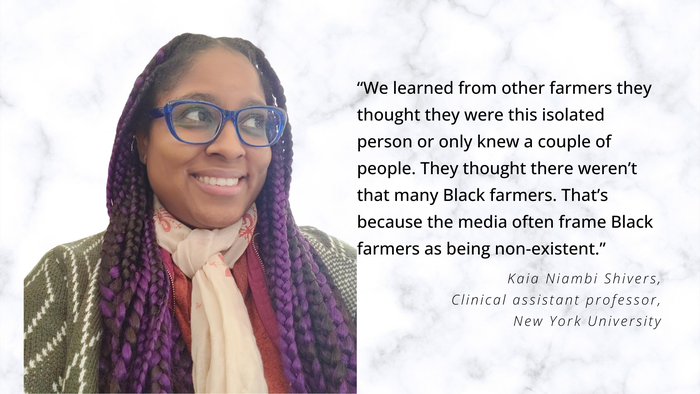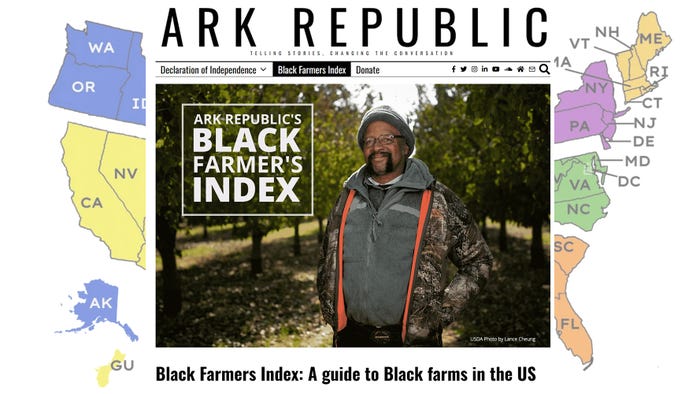Nonprofit Black Farmers Index elevates community, supply-chain equity
During the COVID-19 pandemic, NYU professor Kaia Shivers founded the Black Farmers Index to increase visibility of Black-owned farms and increase food equity. See what it’s become.
January 14, 2025

At a Glance
- The free, online Index includes more than 1,300 Black farmers who now have more access to buyers and resources.
- Nonprofit trade organizations can access the Index to diversify their membership, increase opportunities and offer support.
- The Black Farmers Index boosts food equity as it strengthens diverse connections in the natural and organic food industry.
When she isn’t commuting from Philadelphia, Pennsylvania, to New York to work at New York University, Kaia Niambi Shivers loves working on the Black Farmers Index, a nonprofit she founded during the COVID-19 pandemic.
“I work a 9-to-5,” says Shivers, a clinical assistant professor in the Liberal Arts Department. “Black Farmers Index is my passion project, so when I say I’ve got a lot going on, I’ve got a lot going on.”
The NYU professor provides writing and journalism instruction and has been, as she puts it, “an active member of the faculty’s Diversity, Equity and Inclusion development” who launched the first Black history initiative within its liberal studies program.
At the intersection of race, ethnicity, gender, sexual identity, difference and inclusion, Shivers has focused her career on questions about poverty and discrimination that surround politics and systemic racism. Before the pandemic started, Shivers took a two-year assignment to teach students at NYU’s campus in Florence, Italy. She was six months into her contract when Italy shut down due to the COVID-19 pandemic.
Instead of returning to the U.S., she quarantined in Italy. “I was drinking wine and eating cheese there, even though I’m lactose intolerant,” she says.
She saw the food shortages. “I started seeing the lines,” Shivers says. “That [U.S.] farmers were forced to throw out their milk. It bothered me a lot. I felt survivor’s remorse that I was alright in Italy.” She also knew that during an economic blowout of a country, those who are the most vulnerable are hit first.
“The Black community always says when America has a cold, the Black community has pneumonia,” Shivers says. “I wanted to do something.
“I had already been following Black farmers for some years,” she says. “I come from Black farmers who were forced out of the South.” Unlike many of their colleagues, she knew that Black farmers were not being forced to dump their food because they weren’t under any kind of government contract.
“Black farmers have largely been maligned by the government,” Shivers says. That’s when she created a list, a solutions-oriented journalism project, to direct folks to Black farmers.
“This is a media project,” says Shivers, founder and president of the Black Farmers Index. “Because I’m a journalist. I’m not a grower. I always tell people, I kill shit. I kill cacti. It’s been that bad.”

Racial discrimination captivates the nation
The Black Farmers Index is based on the Green Book, a publication that helped Black Americans find Black-owned and non-discriminatory businesses, including safe places to eat and stay from the 1930s to the 1960s.
On April 14, 2020, Shivers launched the Black Farmers Index on the Ark Republic, a small multi-media publishing website she created. The list included the names of 150 farmers and growers.
“This was before George Floyd,” she says. “I just went on social media sites looking for farmers.” Then on May 25, 2020, Floyd, a 46-year-old Black man, was murdered by police officers in Minneapolis, Minnesota.
“I started getting emails and phone calls from people, restaurants and major food suppliers, asking if I could locate Black farmers in their respective areas of the country,” she says. “Farmers started calling me saying they knew someone.” Each time she added a farmer, their business would increase. “That’s when I knew this was a thing. Because I was in Italy, all I could do was collect the information.”
Shivers pitched the idea of creating a nonprofit. Two of her four sisters, Amara Brown and Ayanna Shivers, agreed to help back the project. “The other two were like we don’t have time for it,” Shivers says with a laugh. In July 2020, the Black Farmers Index became a nonprofit, officially earning 501(c)3 status in October 2021.
“We’ve just taken off since then,” Shivers says.
Also called The Index—the largest, free public listing of Black agriculturalists in the U.S—includes a map and lists more than 1,300 farmers and growers by region and state within its online database. Each listing includes pertinent information such as a farmer’s or grower’s name, contact information including website, email and phone number, what is being grown and the city where they are located.
It was a conscious decision, Shivers says, to list traditional farmers as well as non-traditional farmers and growers. In the United States, a farmer’s status is connected to acreage, Shivers says, and a medium-sized farm, which is around 100 acres, is far bigger than the average Black farmer. “We were coming across people who were growing food and selling it to their community on a half-acre in their backyard,” she says. “So, we revamped our understanding of what a farmer and grower was.”
She also felt it was important to include beekeepers, fishermen, shrimp catchers, oystermen, foragers and others within the agricultural industry.

The Black Farmers Index, inspired by the Jim Crow-era Green Book for Black Travelers, originally included just 150 farmers and growers. Credit: Ark Republic/New Hope Network
Ways for Black farmers and growers to thrive
Initially, the project was simply a list of Black farmers and growers.
“As we talked to more and more famers, there were so many other things they needed,” Shivers says. “We knew the needs of the farmers were as much as the needs of the consumer, and we branched out into other things.” The nonprofit now focuses on several areas including collecting, assessing and distributing more accurate information about Black farmers and growers while advocating, marketing and providing access to capital.
“Our commitment is so Black farmers can thrive,” Shivers says. It needs to be done in the U.S., she says, by addressing food insecurity, committing to improve the economic-wealth gap and diversifying the food supply chain. It also means, she says, helping Black farmers connect with each to share information, resources and knowledge.
With more than 10,000 followers on Instagram, the Black Farmers Index has become a place for Black farmers and growers to see what others are doing and realize they aren’t alone.
“We learned from other farmers they thought they were this isolated person or only knew a couple of people,” she says. “They thought there weren’t that many Black farmers.
“That’s because the media often frame Black farmers as being non-existent,” Shivers continued. “I can’t tell you how many people have told me I didn’t even know there were Black farmers.”
When she began to talk to the U.S. Department of Agriculture and food nonprofits, the information they were using about the number of Black farmers was roughly from the 1980s and early 1990s. While the USDA has a Census of Agriculture, many Black farmers didn’t want to fill it out, Shivers says.
“Back in the day, that was a way for a lot of Black farmers and their land was targeted,” Shivers says. “It is etched in the minds of a lot of farmers and their heirs that you do not trust the USDA and definitely not the USDA census because you had to provide a lot of detailed information.”
That’s been well-documented in cases such as Pigford v. Glickman, a class action lawsuit against the USDA alleging discrimination that resulted in Black farmers losing their land and farms. According to NPR, in 2022, the department granted direct loans to only 36% of farmers who identified as Black. In July, Congress authorized “a historic payment” of $2.2 billion, as part of the Inflation Reduction Act, to help farmers who faced discrimination in USDA lending programs as well as another $3.1 billion for loan relief.
Even with this recent payout, Shivers says many Black farmers still struggle to get money.
“I recently was on the phone with a pastor from Mississippi,” Shivers says. “If you look at the numbers, Mississippi got the largest part of the payout, but this pastor was telling me that he probably knows upwards of 100 Black farmers that didn’t get the payout, whether they didn’t know how to do it, or some were even scammed because somebody presented themselves as helping them, or they didn’t have the Internet to fill out the paperwork.”
Other farmers have had food stolen at processing centers. Shivers says a farmer in Georgia told her he had 1 ton of pecans stolen. “And nothing was done,” Shivers says. “These farmers have PTSD.” That’s why it’s hard for many Black farmers to trust organizations within the food industry—or for the industry to get accurate numbers on how many Black farmers are farming organically, she says
That’s something Stephanie Jerger, vice president of operations at Organic Trade Association, has seen as the organization has created partnerships with groups like the Black Farmers Index, in the hopes of adding more diversity when certifying organic operations and farmland.
“It is well-known as an industry that a lot of Indigenous, Black and Brown farmers are farming organically, but are not certified,” Jerger says.
“The racial component is probably equally as large as the regulatory component,” Jerger says. We get that in feedback and we talk to farmers all the time. The USDA acknowledged it for themselves, they have a history of racism. This payout of reparations is certainly an acknowledgment of the historic disfranchisement of Black farmers.”
Many Black farmers see getting certified organic as something that is elite and out of their reach because of the regulatory burden and costs involved, Jerger says.
“You have a $70 billion industry where we haven't really carved out the path for someone who is small,” Jerger says. That’s why, she says, OTA created its Diversity and Entrepreneurship Program where participants received a two-year membership to the trade association and $750 towards the organic certification process, coupled with training workshops and other resources.
But it starts with having access to Black farmers. That’s what makes the Black Farmers Index unique. “They started with this idea of just gathering information, by reaching out to Black farmers,” Jerger says. “Because this idea that ‘I can’t find a Black farmer’ just isn’t true. They made it easy with their database of more than 1,200 farmers that’s free. I don’t know of another directory like it.”
This article originally appeared on Organic Produce Network, a New Hope Network sister website. Visit the site for information and education relevant to the organic produce industry.
About the Author
You May Also Like





